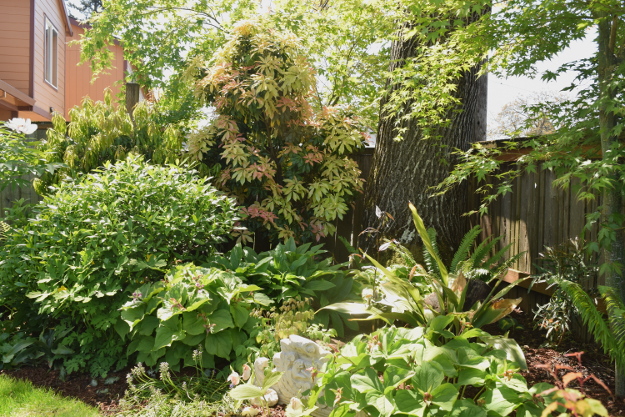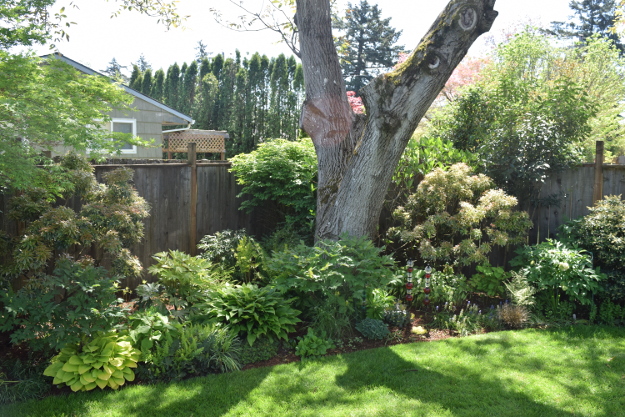
While many gardeners have been sprinkling coffee grounds, brewing compost tea, and painting pruning cuts, Dr. Linda Chalker-Scott has been busy destroying gardening myths like these. One by one, the fiery University of Washington Associate Professor and Extension Horticulturist has been debunking gardening beliefs and practices that don’t hold up to scientific scrutiny. Most recently, she has taken aim at a belief that has rooted in like bindweed: the notion that chemicals in walnut trees stunt and kill nearby plants. A paper Chalker-Scott published earlier this year asserts that, in reality, the killer walnut tree theory has little basis in fact.
I say “little basis” rather than no basis. Her exhaustive study of the literature did turn up experiments that revealed a kernel of truth to the idea. In the lab, when juglone (a chemical produced by walnut trees) was applied to germinating seeds and seedlings, the result was indeed “stunting, wilting, and necrosis” of the young plants. However, in the field, this phenomenon (known as allelopathy, which translates to “death to others”) has never been observed in a legitimate scientific experiment. Researchers have concluded that, in the landscape, most of the juglone in the rootzone of a walnut tree is soon broken down by microorganisms in the soil, or it becomes tightly bound to clay particles. It basically disappears.
Traditional wisdom also holds that walnut tree mulch is suspect. Many believe that toxic chemicals in walnut wood chips suppress plant growth. Chalker-Scott addresses this concern, too, pointing out that virtually no hydrojuglone (which becomes juglone in the soil) is present in the wood of the walnut tree. It is mostly in the roots and hulls. She advises gardeners, “Use walnut wood chips for mulch if you have them. They will not harm plants and work just as well as those from any other woody species.” (If you’re aware of her work, you know that Linda Chalker-Scott is a BIG fan of wood-chip mulch.)

When promoting the idea of the toxic walnut tree, gardening experts sometimes cite personal observations of the phenomenon, but without scientific controls, who’s to say it wasn’t merely root competition or too much shade or some other factor that made their plants struggle? Competition for water and nutrients is fierce under a mature walnut tree.
In advocating for caution around walnuts, other authorities, Chalker-Scott says, cite one of two Extension publications. This is where it gets really interesting. The first article, from Ohio State University (Funt and Martin 1993), was pulled from the Ohio State website for being out of date. You cannot find it anywhere and read for yourself the claims it makes. The other one, from Cornell (Crist and Sherf 1973), is nowhere to be found either, and as far as one Cornell librarian can tell, it never existed at all! The original citation of it was simply a mistake, and no one bothered to verify it.
Dr. Chalker-Scott’s “Do Black Walnut Trees Have Allelopathic Effects on Other Plants?” was published in March of this year. I had hoped that by now, word would have gotten out and garden gurus would have changed their tune. Alas, a quick internet search for “Extension walnut toxicity” reveals the same regurgitated warnings, the same lists of “tolerant” and “sensitive” plants. A partial list of Extension sites still promoting this dubious message includes:
Penn State
University of Wisconsin
Kansas State
Iowa State
Purdue
Michigan State
University of Delaware
Virginia Tech
University of Illinois
University of Nebraska
University of Missouri
University of New Hampshire
Kudos, though, to the University of Maryland! It cites Dr. Chalker-Scott’s paper and concurs with her results.

Now, is Linda Chalker-Scott’s paper the last word on walnut toxicity? No, that’s not how science works. Many questions remain, and hopefully future research will shed light on these questions and improve our understanding of the subject. One thing I wonder about is all of those anecdotal observations of plants dying under walnut trees. Could there be some truth to the stories after all? Maybe future studies will show that there are some situations in which it does happen.
Another thing I’m curious about is the plant’s manufacture of hydrojuglone/juglone. If it isn’t effective in killing competitors in the landscape, then why does the tree produce it? Isn’t there a cost (an investment of energy and resources) to the tree in producing this chemical? Is the tree in the process of evolving a more effective version of juglone? Or, was juglone more effective at one time, but microorganisms have evolved to remove it from the soil so that it doesn’t affect the plants they rely on? Or, is the toxicity of juglone merely a side-effect? Perhaps the chemical serves some other purpose for the tree.
We don’t yet know the whole story, but in the meantime, please, gardeners and horticultural professionals, let’s stop spreading misinformation and hearsay.
The post The Myth of the Killer Walnut Tree first appeared on The World's Best Gardening Blog.